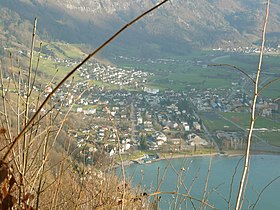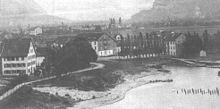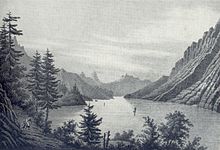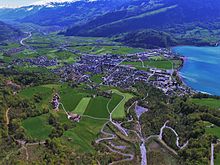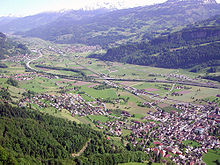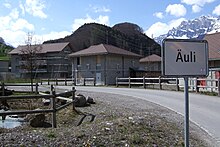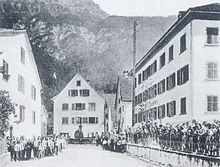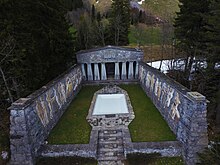Walenstadt
| Walenstadt | |
|---|---|
| State : |
|
| Canton : |
|
| Constituency : | Sarganserland |
| BFS no. : | 3298 |
| Postal code : | 8880 Walenstadt 8881 Walenstadtberg 8881 Tscherlach 8892 Berschis |
| Coordinates : | 742 513 / 220113 |
| Height : | 425 m above sea level M. |
| Height range : | 419–2384 m above sea level M. |
| Area : | 45.68 km² |
| Residents: | 5679 (December 31, 2018) |
| Population density : | 124 inhabitants per km² |
| Website: | www.walenstadt.ch |
| Location of the municipality | |

Walenstadt ( Romansh ) is a political municipality in the south of the Swiss canton of St. Gallen . It is located on the east bank of the Walensee in the Sarganserland constituency and includes the four local communities Walenstadt, Tscherlach, Berschis and Walenstadtberg . With an area of 45.81 km², it is one of the canton's larger municipalities in terms of area.
geography
With the help of granite and verrucanofindling as well as glacier cuts it can be shown that in the Seeztal during the last ice age the ice covered the valley floor up to 1400 m high. When the ice masses melted, raging torrents formed, which still fall down the steep slopes of the Churfirsten today . Towards the south, the Churfirsten drops almost vertically from 2306 m to Walenstadtberg and to Walensee to 419 m .
To the north of Walenstadt is Alt St. Johann (Toggenburg constituency), to the east of Grabs (to the Werdenberg constituency), to the south of Flums and to the west, bordering the Walensee, the community of Quarten .
Walensee and the rivers
- Main article regarding Linth correction see Linth correction .
The Seez rivers (formerly Oo) and the inland canal flow into the Walensee from the Walenstadtner side .
Until the so-called Linth correction, the only outflow from the Walensee was the Maag , into which the Linth flowed. Due to river blockages, there was increased flooding in Walenstadt and Weesen in the 18th and 19th centuries. In 1811, the Swiss civil engineer Hans Conrad Escher von der Linth proposed a correction to direct the Linth coming from the Glarnerland into the Walensee and to route a new artificial Linth Canal as an outflow from the Walensee into the Zürichsee . The major corrections to the Linth were completed in 1816. From mid-1850, the draining of the Seeztal was pushed ahead. The former outflow of the Walensee was called Maag; the runoff of Lake Zurich is still called the Limmat (an abbreviation of the names Linth / Maag: Limmat).
climate
Walenstadt is located in a moderate climate zone. The average annual temperature is a mild 10.5 ° C. The warmest months are July and August, with temperatures averaging 19.5 ° C. The climate of Walenstadt is shaped by the neighboring Walensee, the frequent foehn and the Bise . It also happens that double-digit temperatures can be measured in winter, or that the daytime temperature rises more slowly compared to surrounding villages because of the cooling down Lake Walen. Some palm trees and tropical fruits also grow, but not to the same extent as in the fifth, which is one level milder. Difference and meteocentrale.ch.
history
The first name Walenstadt had was Ripa Vualastad ( Ripa means bank). It was found in the year 831 AD in a property register of the Frankish king Ludwig the Pious . Formerly a Roman road passed around the Walenstadt region.
The Romansh mixed with other languages so that Ripa became Riva in the name . When the Alemanni advanced to Weesen, they saw that today's Walenstadt could only be reached by ship, as the Churfirsten and Kerenzerberg were too steep. When they got there, they did not understand the language of the Walenstadt people, so they changed Riva Vuahalastad to Vualahastade , which means "the French bank" ( Welsch was another name for Romansh or Latin). They called today's Walensee Vuahalasee , the "Welschen See". The city name was changed over time to Vuahalastad , then Wallastatt and finally to Wallenstadt .
The waterway from the Rhine via Lake Zurich to Lake Walen as far as Italy ended in Walenstadt in the Middle Ages. From Walenstadt, the goods had to be reloaded from the ships to carts in the Sust at Hafenplatz. This was the only way of transport, as there was no overland route from Weesen to Walenstadt before 1848. Therefore, the respective owners of Walenstadt and Weesen had the entire movement of goods under their control. The Kyburgers knew of this power and took possession of both places in the Middle Ages. Between 1240 and 1260, city walls were built in Weesen and Walenstadt. Gates and towers and a separate moat were to make the two cities war-proof. Count Rudolf von Habsburg inherited the Kyburg possessions in 1271. In 1462 the judicial district of Walenstadt was separated from the Habsburg rule of Windegg and was occupied by the estates of the Old Confederation . In 1483 they bought the county of Sargans from the last count of Werdenberg-Sargans and united them with Walenstadt to form the bailiwick of Sargans. Until 1798, Walenstadt was administered by a governor from Sargans. The city council of Walenstadt, however, retained the lower court, while the federal governor in Sargans exercised high jurisdiction. On March 3, 1798, the Confederates released Walenstadt into freedom. Due to the enforced adoption of the Helvetic Constitution , this independence was terminated on June 4, 1798 when the law on the reorganization of the cantons came into force. With this law, Walenstadt became part of the Helvetic Republic and became the reorganized canton of Linth . Through mediation in 1803, Walenstadt came to the canton of St. Gallen .
The former Habsburg communities of Oberterzen, Mols, Walenstadtberg and Walenstadt formed the judicial district of Walenstadt. This gave Walenstadt citizens many privileges over the Aus-Burgers. The judicial district was administered by the mayor and the city council, which was represented by Walenstadtner, Molser and Oberterzner citizens - but not by Walenstadt. Because the river bed of the Linth had increased with a lot of sand and mud, the outflow of the Walensee was obstructed at the beginning of modern times. Several thousand acres of land had been turned into swamp, and the population of Walenstadt was threatened by malaria .
In 1952 the place name was corrected to today's Walenstadt , the old name Wallenstadt can still be read on the front of the Walenstadtner weaving mill.
Local parishes
In addition to Walenstadt, the local communities Walenstadtberg , Tscherlach and Berschis belong to the municipality of Walenstadt . All villages are connected by train or bus. The local community of Walenstadt includes extensive usable areas on the plain, on the slopes and considerable forest areas. Walenstadt has had special rights in political and judicial terms since it was raised to city status in the 13th century. When the provincial bailiwick of Sargans disintegrated in 1798 and Napoleon's Helveticism put an end to subjecting, everyone living outside the city became full citizens of Walenstadt.
At the suggestion of a Swiss citizen who has been living in Walenstadt for decades, the local citizens at their municipal meeting on March 7, 2008 granted 390 Swiss people who have lived in Walenstadt for more than ten years the right of local citizenship. This doubled the number of local residents living in Walenstadt.
Berschis


The local community of Berschis was part of Flum's rule for many centuries. Although Berschis had its own community, which consisted of many common areas , forests, fields, Alps and meadows, these were only allowed to be used by the local Berschners. Like Tscherlach, Berschis was damaged several times by the floods of the Seez and the Dorfbach. At that time Berschis administered the church funds, the donation of the poor, the school system, the local property and the Alps. The local congregation was able to pay off the communal debts through a considerable amount of wood from its own forests. Above Berschis, on a prominent rock head, stands the St. George's Chapel , the oldest two-aisled church in Switzerland from the 1st millennium.
In 1883 a new water supply system with hydrant pipes was built in Berschis. Seven years later, the Berschner Bach was generously expanded. In the 20th century the local community built many access roads in the forests and Alps of Berschis. In 1977 the «Casaltahaus» parish hall was also renovated. Berschis also has a modern work yard and lots of forestry equipment. Today Berschis has 617 inhabitants.
Tscherlach
Although the "Tscherlach" were serfs of their master (from 1528 to 1767 the Tschudi family, the lords of Gräpplang), the citizens of Tscherlach had the rights of the alpine pasture and common land. The Alps on the Lüsis, in the Ahorn, on Sennis and the commons as well as the forests were used. The floods of the old Seez and the Dorfbach weighed heavily on the citizens: they devastated the village and the surrounding area several times until the creek was finally rebuilt in 1884 with the help of the federal government. In 1641 the Lords of Gräpplang financed the construction of a small church in Tscherlach. The reason for this was the poor road connection to the village of Flums, to whose church Tscherlach belonged. The boggy plain often prevented going to church. Tscherlach - tradition reports that the lake often reached as far as the Gräpplang - Tscherlach line during floods. (Tscherlach = Terlacus = earth, terrain by the lake).
In 1779 the Tscherlers broke out of serfdom of the Gräpplang (Tschudi) rule with a purchase and were free forever. With this ransom, the now independent local congregation set up its own municipal code. On October 11, 1876, the part above the Tscherlach church burned down. In 1890 the Tscherler gave their water source to the water company "Chrauchtel". East of the village church in 1907 a flood destroyed five houses and stables.
Today Tscherlach is a small village with 366 inhabitants. The local community is located between Berschis and Walenstadt and is connected to traffic by the main road. The village also has two bus stops. There are no grocery stores, but there is a large village square. In the last 10 years and still today, there has been lively construction in Tscherlach. Primarily single-family houses, typically of a rural design, have been built and are under construction. Numerous families have settled in Tscherlach. There is a well-organized school bus connection so that the small children in particular can safely be taken to the schools in Walenstadt by bus. From 2009 onwards, the unified community may result in a certain restructuring of the schooling, in which classes or parts of classes are integrated into the lower and middle grades of the school in neighboring Berschis. This change comes into force on January 1, 2009.
Walenstadtberg and Knoblisbühl
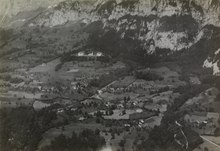
The municipality of Walenstadtberg is located above Walenstadt. The “Berger” belonged to Walenstadt as early as the Middle Ages, although they were disadvantaged Aus-Burgers and disadvantaged compared to the townspeople. At that time, many of the meadows, forests and Alps of Walenstadtberg were only allowed to be used by local residents, a large part of which was shared by the townspeople. Through this sharing and taking, quarrels broke out again and again between the local communities until on February 29, 1814, citizens of Walenstadtberg officially got the same rights and duties as citizens of Walenstadt.
At the end of 1842 a division agreement was signed between the local communities for the common forest and common property: four fifths of the entire property was allocated to the town and one fifth to the mountain. In 1917 a huge avalanche of dust destroyed 14 stables and hay barn above today's sanatorium.
Despite the height of Walenstadtberg, there are a few farms. However, the majority of Walenstadtberg is tied to tourism. There is a rehabilitation clinic in Knoblisbühl. A famous building is the Paxmal built by Karl Bickel . 192 people live in Walenstadtberg and Knoblisbühl.
population
The population increased from 1980 onwards, as apartment blocks began to be built in the 1980s. The infrastructure has also been improved. To this day, more apartment blocks and homes are being built. This is increasingly happening in the Zollacher area, in Walenstadtberg and Tscherlach. The 2008 census showed that 63% of the population are Catholic and 16% Protestant. The remaining 21% have a different denomination.
Municipal council
The current municipal council was elected in 2017 and consists of five members:
- Angelo Umberg, mayor
- Pascale Dürr-Clausen, President of the School Council
- Thomas Schnider
- Bernhard Oehy
- Roland Sidler SVP
A so-called unified community was formed from the three previously existing communities (political community Walenstadt, school community Walenstadt and Berschis) . The request to create the unified community was submitted by two far-sighted people living in Walenstadt. On October 22nd, 2007, the new “municipal code” was explained to the citizens at a specially convened meeting. On November 14th and 16th, 2007, the citizens of the primary school community Berschis and the school community Walenstadt unanimously approved the incorporation agreement with the political community. The new municipal code was also adopted by the citizens without dissenting votes. Walenstadt is now a successful unitary community.
Economy and Infrastructure
traffic
Private transport
By A3 Walenstadt is connected with a semi-port (to and from Zurich) to the motorway network. The government is currently discussing the expansion to a full connection. The main road Walenseestrasse , which touches Walenstadt , leads from Sargans to Murg . The villages of Berschis, Tscherlach and Walenstadtberg are connected by main roads. City traffic is dominated by Bahnhofstrasse and the specialist shops located on it. During rush hour, the vehicles stop moving, and the problem is compounded by an acute shortage of parking spaces.
On July 20, 2007, a commission therefore presented a comprehensive concept for traffic calming. This provides for the conversion of the section between the new and the old town hall into a meeting zone. The Bahnhofstrasse should be single-lane on this section. Another interest group suggested building an underground car park with 61 parking spaces under Bahnhofstrasse. The municipal council will now decide whether the proposal should be processed further.
Public transport
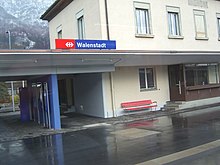
There is an extensive bus network in Walenstadt that connects Walenstadt with Flums and the higher-lying local community of Walenstadtberg. The Schweizerische Südostbahn, founded in September 1853, wanted to build the Sargans – Rapperswil line, but their plans failed due to financial problems. Finally, the Ziegelbrücke – Sargans line was opened in 1859, and in 1927 it was electrified. In 2004, the stations in Mühlehorn, Unterterzen and Walenstadt were converted into self-service stations . Walenstadt's station was given another platform in 2003-2004, and the ticket and information building was closed. Points and signals have been modernized and are now controlled from Chur.
With the timetable change on December 9, 2007, bus operation was taken over by BUS Sarganserland Werdenberg , which uses more modern vehicles. Regional trains to Sargans – Chur and to Ziegelbrücke stop every hour at Walenstadt station. There is a harbor for private boats and a tourist ship on Lake Walen. Walenstadt is connected with the lakeside villages of Murg, Mols, Unterterzen, Quinten, Au and Weesen.
With the S-Bahn St. Gallen project , it was planned to connect Walenstadt and Flums to a half-hourly timetable by 2013. No half-hourly access could be implemented for Flums, but for Walenstadt. Since the 2014 timetable, which was introduced on December 15, 2013, the S4 (which runs as a ring train to St. Gallen) and the RE Zurich – Chur stop at Walenstadt station once per hour and direction . Whereby the S4 in Ziegelbrücke has a slim connection to the S25 of the Zurich S-Bahn to Zurich, which offers a similar total travel time as the RE.
military
As early as 1862, a contract between the local community of Walenstadt and the military department of the canton of St. Gallen was concluded. Since the Zurich – Sargans railway line was opened in 1859, the transport of people and freight was transferred to the railway. Shipping and road transport were almost entirely a thing of the past. Numerous carters and boatmen were unemployed. Before 1859, up to 300 horses were kept in Walenstadt. The large pastures Rossweid, Paschga, Platz (later parade ground, etc.) were no longer needed, which is why the local community made the area available to the military. Walenstadt in 1874 a garrison town and home to a federal military base since that time, a shooting school. The weapon area was constantly expanded and modernized so that year-round operation was possible. Today the Army Training Center (AZH) trains all professional military personnel in basic, advanced training and operational courses. There is accommodation right next to the shooting and practice areas on the lake. One of the most modern simulation-based training systems is currently being built on the Paschga shooting range.
Mining
Walenstadt can look back on a varied mining history, which took on industrial traits from 1862. Two mining companies - Lochezen and Seemühle - were in competition with each other for many decades from 1892 onwards. In 2001 mining was stopped. Today Geobrugg operates a test facility for rockfall safety nets in the Lochezen area.
Healthcare
Walenstadt Hospital
Fridolin Joseph Fidel Huber (born August 13, 1809) inherited as the son of the court clerk Josef Franz Huber. a high fortune and several properties in Walenstadt. Fridolin Huber's only son Leonard Huber died at a young age, so Huber decided to do as much good as possible with his wealth. In 1885, Huber wrote his will in which he bequeathed a piece of land to the political community on Bahnhofstrasse (10,000 francs), a current account balance worth 90,000 francs and ten shares in the Walenstadt colored weaving mill worth 100,000 francs. With this money, the donor wanted to build a hospital for at least thirty people and at least six beds. On December 19, 1885, the municipal council and the government of the canton of St. Gallen approved the construction.
After a conflict between the heirs of the factor and the political community, the town council decided on June 10, 1889 to renounce the Hubers Hospital Foundation. This conflict was about the fact that the citizens were afraid of the "incalculable task" of managing the foundation. After all, around twenty million francs were contributed to this foundation, converted to today's monetary value. In a communication to the government of the canton of St. Gallen, the municipal council of Walenstadt asked to take over the Faktor Huber Foundation in order to “continue the Walenstadt hospital as intended by the founder”. The other heirs did not agree with this supplementary motion, finally they demanded in another citizens' meeting that the municipality of Walenstadt unconditionally renounce the hospital foundation in favor of the heirs.
Since all the communities around Walenstadt had hoped for the promised hospital, the Justice and Police Department of the canton of St. Gallen was able to work out a contract with the heirs after several negotiations and discussions, which the heirs finally agreed to. This contract stipulated that the heirs would receive 80,000 francs in cash instead of the ten shares in the colored weaving mill worth CHF 100,000, the heirs to pay CHF 7,500 in inheritance and additional taxes to the canton and the heirs to give the canton of St. Gallen. On January 1, 1891, the Walenstadt hospital was the first cantonal rural hospital to open. Due to an acute lack of space, the new hospital building was inaugurated on October 23, 1960 after a two-year construction period.
In addition, it should be pointed out that Fridolin Huber provided the Catholic parish and the school with considerable assets during his lifetime. In 1868 he gave the parish a new bell. However, since the citizens insisted on leaving the existing bells in the tower, F. Huber also paid for the necessary heightening of the church tower (neo-Gothic). After that the ringing consisted of 12 bells. After the Second World War (1945) the pastor at the time, C. Helfensberger, had the Brother Klaus Chapel built on the mountain. A bell was removed from the Stadtner church tower and installed in the tower of the Walenstadt-Berger chapel. Fridolin Huber was the owner of a large Renaissance palace in the middle of the town. He donated the stately furnished house to the Walenstadt parents on condition that they set up a good school there. The primary school was then housed in the factor house until 1921. A lot of very valuable furniture and interior fittings have been removed. Some of them can be viewed in museums in St. Gallen and Zurich. In 1929 the palace was demolished. Today the WEW and the milk center are located there.
House Selun
The Selun house in the Fürstgebiet has been offering accommodation for brain injured people since September 2005. After a major carpentry fire in November 2005, the house provided emergency housing for the victims of the fire. With the opening of the Selun house, OVWB (The Association for the Creation and Operation of Housing for the Physically Disabled) would like to give brain-damaged people the opportunity to live independently. This is achieved by rehearsing everyday work. Construction was completed in 2006 and cost CHF 8.6 million.
tourism
Education
On March 19, 1869, the primary school in Walenstadt had 228 students and three teachers. On April 17, 1876, it was decided to introduce a fourth apprenticeship position. However, since no free room was available for this, the students were taught at the unusual school times at the time. In 1879 the lack of space in the former school building near the town hall became acute, so that a classroom from the primary school had to be relocated to the secondary school building on the lake. In 1883, the son of a court clerk, Faktor Fridolin Huber , gave the primary school in Walenstadt his twin house on Rathausplatz for use as a school building. It was a blessing for the people of Walenstadt back then, as the many consecutive years of misery and the high tax burden drove the people of Walenstadt into poverty. On June 27, 1884, after the local community of Walenstadt broke away from the obligation to offer rooms for the lessons of students in the town hall, Huber's house and garden were transferred to the school community of Walenstadt.
In 1910, the voters of the Walenstadt school community decided to open a fund for the construction of a new school building. The First World War and the planning delayed construction for ten years. Most of the money for the construction of the "so expensive and noble schoolhouse" came from Weberei AG (34,400 francs) in Walenstadt, the government council of the canton of St. Gallen (980,000 francs) and the federal government (92,000 francs) ). After a vote on May 16, 1920, construction began. The new building was inaugurated on July 23, 1922 with a large children's parade and festivities in the city. The new building, which cost 839,529.90 francs (around 50 million francs today), was dedicated to the Swiss engineer Hans Conrad Escher von der Linth , who freed the villages around Lake Walen from annual floods at the beginning of the 19th century.
The picture on the right side shows the old factor palace of Fridolin Huber. The photograph is from 1905. School classes before that document the use of the palace as a school building.
Arts and Culture
Carnival
"Rölli Bölli, Suppächnölli, uusä with da Butzi, hojä, hojä, ho!
Haudärä with dä Tuurätee, haudärä with dä Toorä, einä, einä Butzibuäb, einä, einä Höösi! "
With this carnival call, the children of Walenstadt invite the Rölli to run. On Carnival Sunday, at twelve o'clock, the Rölli storm out of the old town hall and run after the children. The Rölli von Walenstadt are traditional fool figures who wear a colorful tattered dress that probably goes back to an older fur clothing. The colors white, red and black as well as the tree of life on the mask go back to mythological and cultic symbols of an ancestor ("old woman"). The Rölli probably go back to a former Rhaetian spring festival. In this custom, the ancestor called the boys of the village together, who were then to drive away the evil spirits of winter, diseases and death in fur clothes, evil masks and loud noisy devices. Today's unwritten law of carnival states that only men are allowed to participate in the Rölli custom.
The mask researcher Werner Stauffacher looked up the history of the Rölli von Walenstadt and found out during his research that the "old" mask was created in 1832 by a carver from Tscherlach. Between 1890 and 1900, the local Schumacher Beat Etter made a copy of the old one, called the “new one”. At the same time, a professional carver from Schaffhausen made another copy of the old mask. The mask, which then cost 100 francs, was called "Gmeindsni" (the mask of the community). Because it was sold to a master locksmith by the name of Schlegel Arnold around 1920, it is occasionally called "Schlosseri". Other masks have the names «Heerä», «Hämmene», «the laughing Jew» or «Schnapsni» and a female «Rockni».
As early as the 1930s, a carnival parade was held annually on Carnival Sunday. In the beginning the music company «Konkordia» organized the happy parades, from 1954 it was more the Walenstadtner Emil Freitag who shaped the carnival parade for five years with carts that focused on a certain topic. In 1959 no more moves were carried out, so that on November 27, 1959 the "Fasnachtsgesellschaft Walenstadt" was founded, which among other things set itself the task of designing and organizing a carnival parade every year. In 1973 the Fasnachtsgesellschaft decided that the original Rölli larvae should no longer be carried during the regular carnival time. The original larvae have since been exhibited in the local museum near the old town hall. The soldiers 'Butzi, which was set up on the soldiers' fountain on the town hall square, was set on fire in 1983, and the fire damaged the soldier figure on the fountain so much that this custom was discontinued. As a replacement, some carnival people created a huge "Huttlewiib" in 1985, which has been hung on wire ropes over the town hall square during the carnival. At the beginning of Carnival, the day of the "Butzuufhanggete", the large Huttlewiib is hung up with musical accompaniment by the Guggenmusik , and taken down again at the end of the Carnival at the "Butzihanggete". In 2002 the Huttlewiib was replaced by a newly sewn giant rolli.
Attractions
Parts of the city wall built around 1240 AD are still preserved. (North and west of the city's hunger).
Churches and chapels
There used to be a small chapel on Klosgasse, east of the cemetery. Pious women, beguines lived there. They looked after those in need of care and the sick. Those who entered the community usually brought their own wealth with them. Own work, the city and the residents provided for their livelihood.
Chapel of St. Wolfgang
Next to the rectory on Herrengasse is the St. Wolfgang Chapel, built in 1741. It was consecrated in 1753 by the Bishop of Chur in honor of the Holy Trinity , the Blessed Virgin Mary and St. Wolfgang. The neighboring rectory was originally built in the Renaissance style. The chapel is assigned to the late baroque style. A valuable Vespers picture on the high altar of the chapel must have been painted between 1400 and 1450. The Gothic crucifixes and the two wooden busts of St. Margaret and Dorothea were created around 1500. During the war of 1939–1945 the chapel was used as a military food store. Thanks to the initiative of pastor Clemens Helfenberger, a comprehensive, stylish restoration took place from 1955. Numerous bourgeois families contributed to the costs through donations. Pictures and statues come from the Gothic chapel that used to be located to the south. There is evidence that this building also housed the chaplaincy and the school.
Protestant church
Towards the end of the 19th century, the number of Protestant believers in Walenstadt grew more and more. The desire for a Protestant church of their own was made, so that the citizens of the community decided to build a new church. After a lengthy search for a suitable building site, the Buntweberei sold a building area of 1,720 m² in the center of the town to the Protestant parish for 10,000 francs. The church plan was designed by the architect Abundi Schmid von Chur and adopted in April 1903. The groundbreaking ceremony took place on September 7, 1903, and the foundation stone was laid on October 25, 1903.
The walls of the church were made of heavy rubble stones like a medieval castle. These came from a former quarry on Walenstadtberg and were carried down into the valley on carts. After a construction period of almost two years, the rough construction was completed on March 24, 1905 with the placement of the weather forecast on the top of the tower. On March 11, 1902, the new church was inaugurated with a town festival. Representatives of the Catholic community, the local community and the political community as well as the men's choir Walenstadt were at the inauguration ceremony. With construction costs of over 195,000 francs, the church was significantly more expensive than the planned 115,000 francs. Between 1908 and 1914, electrical lighting was added later.
In 1958 the bells and the tower clock were electrified. Until the electrification, the tower clock had to be tightened weekly. On April 5, 1990, the church citizens' assembly decided to renovate the Protestant church. The architectural office Busa und Klingler was responsible for the construction project. For the construction, which cost around two million francs, Walenstadt's tax rate was increased from 18 to 27 percent. On December 1, 1991, the renovated church was finally consecrated again.
Town Hall Square
Today's Town Hall Square is now considered intersection of Bahnhofstrasse , Seestrasse to Herrengasse and the old road used. In the middle is a soldiers' fountain, which Karl and Ernst Hänny built in 1920 to commemorate the occupation of the border between 1914 and 1918. The old town hall was built on and in the preserved walls after the town fire in 1799 and was the center of the former town center. The town hall was renovated in 1977, and an arcade was added to the basement. The central pointed arch is covered with a city coat of arms of Walenstadt, a city and state coat of arms of Sargans . In 2004 the old town hall was renovated again. Today the vaulted cellar of the building is used as a local museum. During the renovation in 1977 excavations revealed that the shortened, Gothic portal was higher and stylish. The original limestone door sill is approx. 80 cm below the current street and under the inner paving. This came about through the filling of the roads over the centuries, with rubble carried from the nearby torrents into the town. The debris, which often reached the town through the steep slopes of the Churfirsten, was distributed over the centuries by hand, mostly along the paths of the time. As a result, the streets and alleys increased in places by up to one meter. In old buildings, this is the reason why the ground floors are often lower than the entrances. (The difference between the heaped-up paths and the "old" ground floors was achieved with small stairs).
Paxmal
The Paxmal is a peace memorial built by Karl Bickel . For four decades, Bickel had worked with the printing and stamps department of the PTT general management. As a thank you, Bickel gave the Paxmal to the federal PTT administration in 1966. The monument, often referred to as a place of peace, is located near Walenstadtberg at 1,300 meters above sea level and was built from 1924 to 1949.
Seebühne Walenstadt - Swiss musicals
Since the summer of 2005, musicals on Swiss themes have been performed on the Walensee stage in casual succession. It started with the world premiere of the Heidi musical based on the novel by Johanna Spyri . The musical Heidi is a musical theater about the cultural figure Heidi . The stage, which represents a quarter circle, was set up for the first time in 2005 on the beach of the Walensee. The sequel "Heidi 2" was played for the first time in summer 2007 and performed for the last time in summer 2008. In 2010 a Swiss theme followed with “ The Black Brothers ” (world premiere in 2007 in Schaffhausen). In 2012, “ Tell - The Musical ”, another Swiss theme, was presented as a world premiere on the Walenstadt floating stage .
Personalities
Sons and daughters of the church
- Franz Josef Benedikt Bernold (Bard of Riva) (1765–1844), educated citizen of Walenstadt
- Fridolin Huber (1809–1886), last factor, great benefactor, co-founder of the weaving mill
- Edward Walter Eberle (1864–1929), American admiral
- Karl Bickel (1886–1982), artist, graphic designer, brand engraver, creator of PAXMAL
- Eduard Thurneysen (1888–1974), Swiss Protestant theologian
- Heinrich Johann Müller (1901–1972), winemaker with extensive knowledge of local history
- Peter Steiner (1917–2007), advertising actor «Cool Man»
- Kurt Bürer (1925–2009), CVP National Council: (1975–1987)
- Gustav Däniker (major) (1928–2000), military journalist
- Josef Ackermann (* 1948), bank manager
- Marco Büchel (* 1971), Liechtenstein ski racer
- Daniel Anrig (* 1972), commander of the Pontifical Swiss Guard in Rome
- Alexander Hug (* 1975), ski mountaineer
- Martin Kohler (* 1985), racing cyclist
- Marco Pfiffner (* 1994), Liechtenstein ski racer
- Lara Casanova (* 1996), snowboarder
- Boris Babić (* 1997), football player
Personalities associated with Walenstadt
- Paul Etter (1939–1985), mountain guide, first winter ascent of the Matterhorn north face in 1962
- Heidi Hanselmann (* 1961), Government Councilor, District President 2008
- Annalea Hartmann (* 1965), born in Berschis, beach volleyball player
- Enrico Lavarini (* 1948), musician, conductor, flautist, composer, teacher and educator
- Luzius Wildhaber (* 1937), former judge in Switzerland at the European Court of Human Rights, citizen of Walenstadt
literature
- Erwin Rothenhäusler, Dora Fanny Rittmeyer, Benedikt Frei: The Art Monuments of the Canton of St. Gallen, Volume I: Sargans District. (= Art Monuments of Switzerland. Volume 25). Edited by the Society for Swiss Art History GSK. Bern 1951. DNB 750089172 .
- Paul Gubser: Walenstadtner Chronik . Sarganserländer Verlag, Mels 2007, ISBN 978-3-907926-44-4 .
- Paul Gubser: St. Luzius and Florin Walenstadt . Catholic parish, Walenstadt 1987.
- Franz Fäh : From the history of the municipality of Walenstadt and the Sarganserland . Wallenstadt 1900.
- Hans Hagmann and Jürg Steinmann: 100 years of the Evangelical Church in Walenstadt . Walenstadt 2005.
- Society for Swiss Art History: Art guide through Switzerland. ISBN 3-906131-95-5 .
- Franz Fäh: Wallenstadt . Memorial
- Guido Städler: Fasnachtsgesellschaft Walenstadt: a sprightly 50-year-old, 1959-2009 . Sarganserländer Verlag, Mels 2009, ISBN 978-3-907926-54-3 .
- Guido Städler: 200 years of the Walenstadt public school 1809-2009 . Walenstadt municipality, 2009.
- Guido Städler: Walensee Shipping - Linth Shipping . Sarganserländer Verlag, Mels 1996, ISBN 3-907926-11-0 .
- Guido Städler: "Walensee-Schifffahrt / Linth-Schifffahrt" (175 years of steam and motorized shipping on the Walensee 1837 - 2012), Sarganserländer Verlag Mels, 2012, ISBN 978-3-907926-60-4 .
- Heinrich Johann Müller: Stories and history of the clever city original. the winemaker Feilenhauer. (1901-1972)
- Collection of Swiss Legal Sources , XIV. Department: The Legal Sources of the Canton of St. Gallen, Part Three: The Landscapes and Country Cities, Volume 2: The Legal Sources of the Sarganserland by Sibylle Malamud and Pascale Sutter, Basel 2013 (online) .
Web links
- Official website of the municipality of Walenstadt
- Local community Walenstadt
- Paul Gubser: Walenstadt. In: Historical Lexicon of Switzerland .
- Paul Gubser: Berschis. In: Historical Lexicon of Switzerland .
- Paul Gubser: Tscherlach. In: Historical Lexicon of Switzerland .
- History of the Seemühle and Lochezen mines, Walenstadt
- The chapel of St. Georgen and Lourdesgrotte Berschis
Individual evidence
- ↑ Permanent and non-permanent resident population by year, canton, district, municipality, population type and gender (permanent resident population). In: bfs. admin.ch . Federal Statistical Office (FSO), August 31, 2019, accessed on December 22, 2019 .
- ↑ Historical Lexicon of Switzerland
- ↑ a b walenstadt.ch: Population statistics as of December 31, 2008 ( Memento of February 27, 2011 in the Internet Archive )
- ↑ sg.ch: New S-Bahn St. Gallen from December 2013 ( page no longer available , search in web archives ) Info: The link was automatically marked as defective. Please check the link according to the instructions and then remove this notice. , dated November 9, 2007.
- ^ History and pictures of the Seemühle and Lochezen mines . arganserland-walensee.ch. Retrieved November 22, 2019.
- ↑ Walenstadtner Chronik , p. 344.
- ↑ Walenstadtner Chronik , p. 345.
- ↑ Walenstadtner Chronik , pp. 346–349.
- ↑ Tagblatt , article from Friday, July 20, 2007.
- ↑ Walenstadtner Chronik , p. 340.
- ↑ Walenstadtner Chronik , pp. 342 and 343.
- ↑ Christina Schlatter: Sources, Cults, Magic Mountains: Landscape Mythology of Eastern Switzerland and Vorarlberg . Ed. Amalia, Grenchen 2005, ISBN 3-905581-26-4 .
- ↑ Walenstadter Chronik , pp. 354–359.
- ↑ Walenstadter Chronik , pp. 359-360.
- ↑ Walenstadter Chronik , p. 362.
- ↑ a b Walenstadter Chronik , p. 363.
- ↑ Walenstadter Chronik , p. 364.

